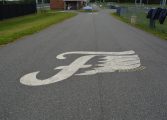Noticing the pair of socks which appear in the outfield of Fenway Park, for which the turf manager got a prize; and Cal Rifken’s number eight cut into the mowing pattern of Camden Yards, other patterns now appear seasonally in my garden plans. I like a pattern to appear in the same color with varying perennials like the tradescantia which are interplanted with siberian iris and Michaelmas daisies at Ladew gardens in Monkton, Md. The pattern remains but the flower changes.
I’ve seen an owner’s initial planted in a lawn, or a name or logo planted outside a business, but this is more often done with the hardscape, not the plant material. Formal gardens often have patterns repeated in parterres; matching squares which are intended to be viewed from a balcony or terrace. ‘Bedding’ plants, annuals historically promoted by nurseries to stimulate sales, work well. The most common are impatiens, marigolds, begonias, lantana, and salvia. Perennials which keep their leaves will also show the design. When using two different short sedums, similar in leaf, the pattern only shows up when they bloom, one red and one yellow. Different patterns can appear at different times if the bloom season varies. Some patterns can include a seasonal surprise like ‘naked ladies’ emerging mid-summer in a bed of coleus.
Knot gardens are an old form of planting pattern. Often planted in herbs, many varieties of thyme, germander and santolina with varying leaf color enhance the effect. Planted in a double figure eight, one loop in one plant and another loop in a different plant, alternating where the loops cross, the illusion of plants tied in a knot is created. Some designs copy Europe’s formal gardens using fleur de lis patterns and various swirls interspersed with colored pebbles. The symbols of the four suits of cards make a fun parterre design.
I have planted a yin yan pattern in two kinds of turf grass. I’ve done one similar in grape hyacinth (muscari) and species tulips which bloom at the same time, blue and red. Less formal patterns can emerge appearing like a river of blue muscari through a sea of yellow daffodils. More subtle patterns can be formed with slightly varying shades of white, yellow and orange narcissus. A rainbow would be a nice pattern and, if I get clever enough, I may try to plant a portrait. I’d have to find a good viewing perch as it would only be seen from a distance.
Sunny Lenz is a professional gardener and landscape painter working in and around central Virginia.




